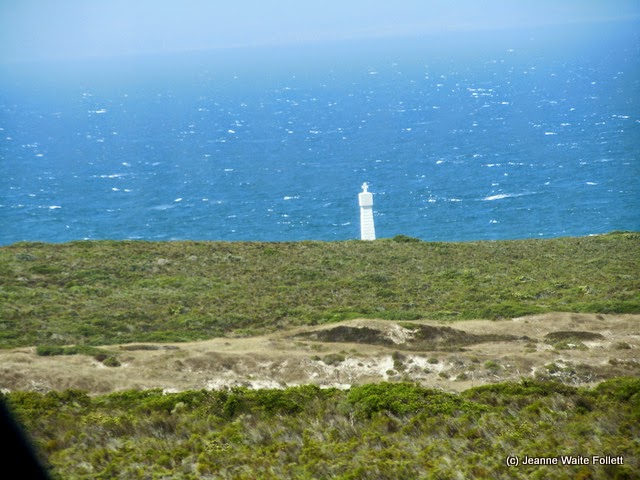The Africa Journals
Chapter 60
The Cape Peninsula
Part Two
In our passage from the Cape of Good
Hope the winds were mostly from the westward with very boisterous weather…—William Bligh
I have a bunch of photos to show you, but not much to say
about them, so I’ll tell you a story and intersperse it with the photos of Cape
Point.
Back-tracking a bit:
Before we reached the Cape of Good Hope, we passed two monuments, one of
each side of the road. The first one is
in memory of Bartolomeu Dias, the Portuguese explorer who was the first known
European to round the Cape. He called it
Cabo das Tormentas, the Cape of
Storms.
Upon his return to Portugal, Dias had to explain to
Portuguese King Joāo about the mutinies and attacks from natives that prevented
him from venturing farther east, and thereafter fell into disfavor with the
king.
The king changed the name of the cape to Good Hope (not having been there himself to understand
the basis of the name given it by Dias) because it opened trade routes for ships to the riches
of the Indian Ocean settlements.
 |
| Monument to Bartolomeu Dias |
A decade later another Portuguese explorer named Vasco de
Gama made a successful voyage around the tip of Africa and arrived in the
Orient in 1497, thereby trumping Dias.
This was a monumental success for Portugal and other European
traders. No longer would ships have to
cross the disputed Mediterranean Sea nor caravans the highly dangerous Arabian Peninsula
by land to reach the riches of the East, and it also cut out a lot of middle-men who cut into the profits.
Not only did it open the world to global imperialism, it
also began the era of vast Portuguese colonial settlements in Africa.
As for Dias, his disfavor continued until 1500 when the king
authorized another expedition to the Orient, and while Dias was not commander
of the 13-ship fleet, he did captain four vessels. The fleet encountered ferocious storms at
Good Hope in which four vessels were sunk with all hands lost, including the one Dias was on, thus proving his original name Cape of Storms was the appropriate one, not that it did him any good then.
All of this means that there are Dias and de Gama statues and monuments are
all over South Africa.
 |
| Monument to Vasco de Gama |
What’s at Cape Point?
Not any more statues, but a funicular, which is a little railroad that takes
tourists up to the Cape lighthouse.
This is the second lighthouse located at Cape Point, which is higher
than the cape at Good Hope, a mere hop, skip, and a jump away.
 |
| The farthest promontory is the Cape of Good Hope. |
 |
| Cape lighthouse at Cape Point |
The old lighthouse was a bit of a serious problem for
several reasons. One is that because of frequent foggy
conditions, it often was not visible.
Second, it could be seen “too early” and thus, like the Lorelei rock in
the Rhine River in Germany, lured ships to destruction because they approached
too closely.
One of its victims was the Portuguese ocean liner Lusitania which wrecked on nearby rocks in 1911,
with the loss of eight people when a lifeboat capsized. This is not to be confused with the British liner Lusitania that was sunk in 1915 by a German U-boat.
Thereafter, the new lighthouse was built lower down, 285
feet above sea level. It cannot be seen
by ships approaching from the west until they are safely far away from shore.
When we arrived at the lighthouse area our herd bolted for
a really nice restaurant for lunch. We
had a time limit of an hour to eat, go up to the lighthouse, and return to the
coach. Busy restaurant, long line for the funicular, and lots of things to see at the top. An hour?
 |
| My shrimp salad. |
And then there’s the Flying Dutchman funicular, no doubt
named after the fabled 17th century Dutch man-o-war ship that
wrecked off the cape and is now a ghost ship, forever unable to reach
shore. A number of sightings of the
ghost ship have been reported, the last being in 1942 when it appeared off the coast
of Cape Town— only to disappear. Seeing
the glowing apparition is said to be a portent of doom.
Good thing I didn’t know that before I rode the funicular up
to the lighthouse.
 |
| Who has the right of way? The car going up or the car coming down? |
 |
| Note how the cable and tracks move one car to the side to allow passing. |
A funicular is a
railway in which two tram-like cars are attached to each other by a cable, each
acting as a counterweight to the other and thus reducing the energy required to
make one car ascend a steep slope. The
cable runs through a pulley at the top, and an electric motor operates a winch.
We blew our one hour time limit all to heck at this
beautiful spot, mostly because the line for the Flying Dutchman was very long. As we left the parking
area and headed downhill, wild eland and ostriches roamed the rocky coastline.
 | |
| The Wild Bunch. |
 |
| Overview of the Cape of Good Hope with beach parking lot where the sign is. |
 |
| Eland, the largest of the African antelope. |
 |
| Eland |
Stayed turned for Bonnie, Clyde, and Boulders Beach next on your radio dial.

















Good as usual
ReplyDeleteAh, you're reading along, are you?
ReplyDeleteAnother splendid journal of Africa!! I especially enjoyed the photo looking down on the rocky point and the water below.
ReplyDelete